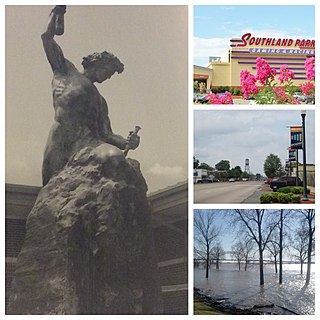
West Memphis is the largest city in Crittenden County, Arkansas, United States. The population was 26,245 at the 2010 census, ranking it as the state's 18th largest city, behind Bella Vista. It is part of the Memphis metropolitan area, and is located directly across the Mississippi River from Memphis, Tennessee.
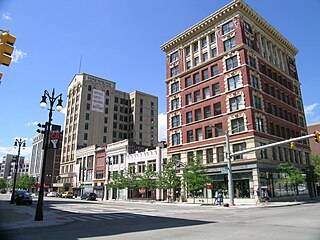
The Broadway Avenue Historic District is a historic district located on a single city block along Broadway Avenue between Gratiot and East Grand River in downtown Detroit, Michigan. It was listed on the National Register of Historic Places in 2004. The Broadway Avenue Historic District joins the Randolph Street Commercial Buildings Historic District, a rare surviving commercial area which dates from the 1840s.

The Broadway Historic District is located along Broadway in Saratoga Springs, New York, United States. It has a twofold character. The southern section is the commercial core of the city, with many of its important public and private buildings, most intact from its peak days as a resort town in that era. North Broadway is a residential neighborhood with many large Victorian houses built by frequent visitors to the town and its spas and racetrack.

U.S. Route 64 is a U.S. highway running from Teec Nos Pos, Arizona east to Nags Head, North Carolina. In the U.S. state of Arkansas, the route runs 246.35 miles (396.46 km) from the Oklahoma border in Fort Smith east to the Tennessee border in Memphis. The route passes through several cities and towns, including Fort Smith, Clarksville, Russellville, Conway, Searcy, and West Memphis. US 64 runs parallel to Interstate 40 until Conway, when I-40 takes a more southerly route.

The Argenta Historic District encompasses significant historic elements of central North Little Rock, Arkansas. The area that is now central North Little Rock was known as Argenta when it was first settled, and remained unincorporated until it was annexed to Little Rock in 1890. William Faucette, a leading Argenta politician and businessman, orchestrated the incorporation of North Little Rock just beyond the annexed area in 1901, and then made a successful petition to separate Argenta from Little Rock into the new municipality in 1903. Subsequent attempts to rename North Little Rock to Argenta have failed.
The Monticello Commercial Historic District encompasses a portion of the historic business district of Monticello, the seat of Drew County, Arkansas. The district was listed on the National Register of Historic Places in 2011.

The Smackover Historic Commercial District encompasses the civic and commercial heart of the small town of Smackover, Arkansas. It consists of sixteen buildings lining a single block of Broadway north of 7th Avenue. The area is reflective of Smackover's explosive growth following the discovery of oil in 1925; most of the buildings were built between 1925 and 1940. They are mostly vernacular commercial buildings, one or two stories in height, with flat roofs obscured by a parapet on the main facade. Also included in the district are the Methodist Episcopal church, the old fire station, and the old city hall and jail. The district was listed on the National Register of Historic Places in 1990.

The Stuttgart Commercial Historic District encompasses a portion of the commercial center of Stuttgart, Arkansas. The district extends along Main Street between 1st and 6th Streets, and includes a few buildings on the adjacent numbered streets as well as Maple and College Streets, which parallel Main to the west and east, respectively. The majority of the district's 76 buildings were built between about 1900 and 1920, and are brick commercial structures one or two stories in height. Notable among these buildings are the Riceland Hotel, the Standard Ice Company Building, and the county courthouse.

The Blytheville Commercial Historic District encompasses most of the central business district of Blytheville, Arkansas, one of the two county seats of Mississippi County. It extends along Main Street between 5th and Franklin Streets, and along Ash Street between 5th and 2nd. Most of the 39 buildings in the district were built between 1890 and 1956, in three phases of development. The two oldest buildings in the district, both dating to c. 1890, are at 112 West Main and 106 East Main. The building traditionally viewed as the anchor of the downtown area is the Kirby-Heath building at the corner of Main and 2nd, built 1901.

The Hardy Downtown Historic District encompasses most of the central business district of the resort community of Hardy, Arkansas. It extends along Main Street, between Church and Cope Streets, and includes a few buildings on adjacent streets. Hardy was founded as a railroad town in the 1880s, but grew by the end of the 19th century into a resort community, serving as commercial center for vacationers from Memphis, Tennessee. Most of the 43 buildings in the district are between one and three stories in height, and of masonry construction. Twenty-four are historically significant, and many of the remaining buildings date to the early 20th century but have been altered in unsympathetic ways. Notable buildings include the Hardy Church of Christ, and the Raymond Daugherty House, one of the community's oldest buildings.
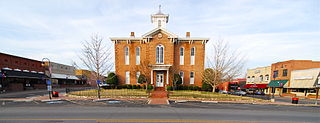
The Pocahontas Commercial Historic District encompasses the historic civic heart of Pocahontas, the county seat of Randolph County, Arkansas. The district includes roughly five-block stretches of Broadway and Pyburn and Everett Streets between US 67 and Bryant Street, and extends across US 67 to include a small complex of industrial buildings and the former railroad depot. Founded in 1836, the center of Pocahontas is dominated by the Old Randolph County Courthouse, a handsome Italianate structure built in 1875 which now houses city offices. It is surrounded by commercial buildings, generally one or two stories in height, most of which were built between 1900 and 1930, although there are a few 19th-century buildings. Later growth extended away from this center. Other notable buildings in the district include the present Randolph County Courthouse and the 1930s Art Deco style Post Office building.
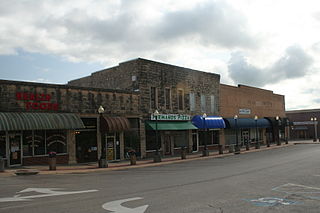
The Mountain Home Commercial Historic District encompasses the historic central business district of Mountain Home, Arkansas, the county seat of Baxter County. The district is centered on the Baxter County Courthouse, and is bounded on the north by East 5th Street, the south by East 9th Street, the east by South Street, and the west by South Hickory Street. Most of the buildings in this area are commercial structures, one or two stories in height, of masonry construction. They are generally vernacular in style, and most were built in one of two periods: between about 1900 and 1920, after the arrival of the railroad, and in the 1950s, when the city experienced another major period of growth. The oldest building is the 1892 Baker Building at 601-603 Baker Street.
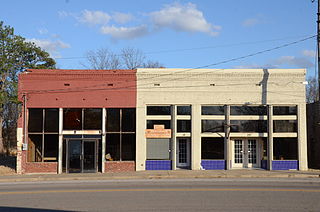
The Hartford Commercial Historic District encompasses about two blocks of buildings in the central business district of Hartford, Arkansas. Extending on the east side of Broadway from just north of Main Street to south of Ludlow Street, they are the only major commercial buildings left from Hartford's boom years of 1880–1920, when coal in the area was mined for use by the railroads. Most of the buildings are single-story brick structures, in typical early-20th-century commercial styles. Included in the district is Hartford's present city hall, which was built in 1910 as a theater.
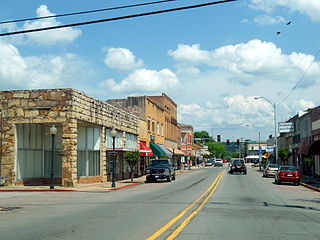
The Ozark Courthouse Square Historic District encompasses the historic late 19th-century center of Ozark, Arkansas. It includes an area two blocks by two blocks in area, bounded on the west by 4th Street, the north by West Commercial Street, the east by 2nd Street, and the south by West Main Street. Most of the buildings in the district were built between about 1890 and 1930, a period of significant growth occasioned by the arrival of the railroad, and are built either out of brick or locally quarried stone. Prominent buildings include the Franklin County Courthouse and the Bristow Hotel.
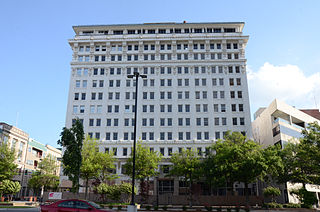
The Capitol–Main Historic District encompasses a well-preserved area of early 19th-century commercial architecture in downtown Little Rock, Arkansas. The district includes 2-1/2 blocks of Capitol Street, extending east from Center Street, one block of Main Street south of Capitol, and one block of 6th Street west of Main. The buildings in this area were mostly built before World War II, and are of a more modest scale than modern sections of the downtown. Notable buildings include the LaFayette Hotel and the Pfeifer Brothers Department Store.

The Heber Springs Commercial Historic District encompasses the early commercial heart of Heber Springs, Arkansas. The district extends along Main Street, between Broadway and 6th Street, including several buildings along some of the cross streets. The area was developed beginning in 1881, and grew in the late 19th and early 20th centuries, featuring a diversity of commercial architecture from that period. Prominent buildings include the Cleburne County Courthouse (1914) and the Morton Building at 101 South 3rd Street, the city's oldest surviving commercial building (1895).
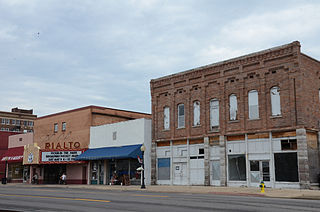
The Morrilton Commercial Historic District encompasses the historic central business district of Morrilton, Arkansas. The L-shaped district includes two blocks of East Railroad and East Broadway, between Division and Chestnut Streets, and three blocks of Division and Chestnut Streets, between Broadway and Vine. This area was mostly developed between 1880 and the 1920s, and was heavily influenced by the railroad, which passes between Broadway and Railroad. Prominent buildings in the district include the Morrilton Post Office, Morrilton Railroad Station, First National Bank of Morrilton, and the Coca-Cola Building.

The Booneville Commercial Historic District encompasses the early 20th-century commercial heart of Booneville, Arkansas. Located on the east side of the 100 and 200 blocks of North Broadway Avenue are line with commercial buildings, most of which were built between about 1900 and 1920. The city had originally been located south of this location, but was relocated beginning in 1899 due to the arrival of the railroad joining Little Rock, Arkansas and McAlester, Oklahoma. Most of the buildings are in typical early 20th century vernacular commercial styling.

The 100 Block of West Broadway Historic District is a nationally recognized historic district located in Council Bluffs, Iowa, United States. It was listed on the National Register of Historic Places in 2002. At the time of its nomination the district consisted of 30 resources, including 22 contributing buildings, and eight non-contributing buildings. The linear district on the east side of the central business district is the north side of Broadway. Developed between mid-1850s and 1928, it is the only section of the street that has maintained its historical integrity. The buildings are one to three stories tall with commercial space on the main floor. While many are vernacular commercial structures, others are the various revival styles of Victorian architecture.

George Woods Mahan Jr. was an American architect based in Memphis, Tennessee. He designed courthouses, many residences, and schools. Many of his designs were Neoclassical architecture style, and several buildings he designed are listed on the National Register of Historic Places (NRHP).


















